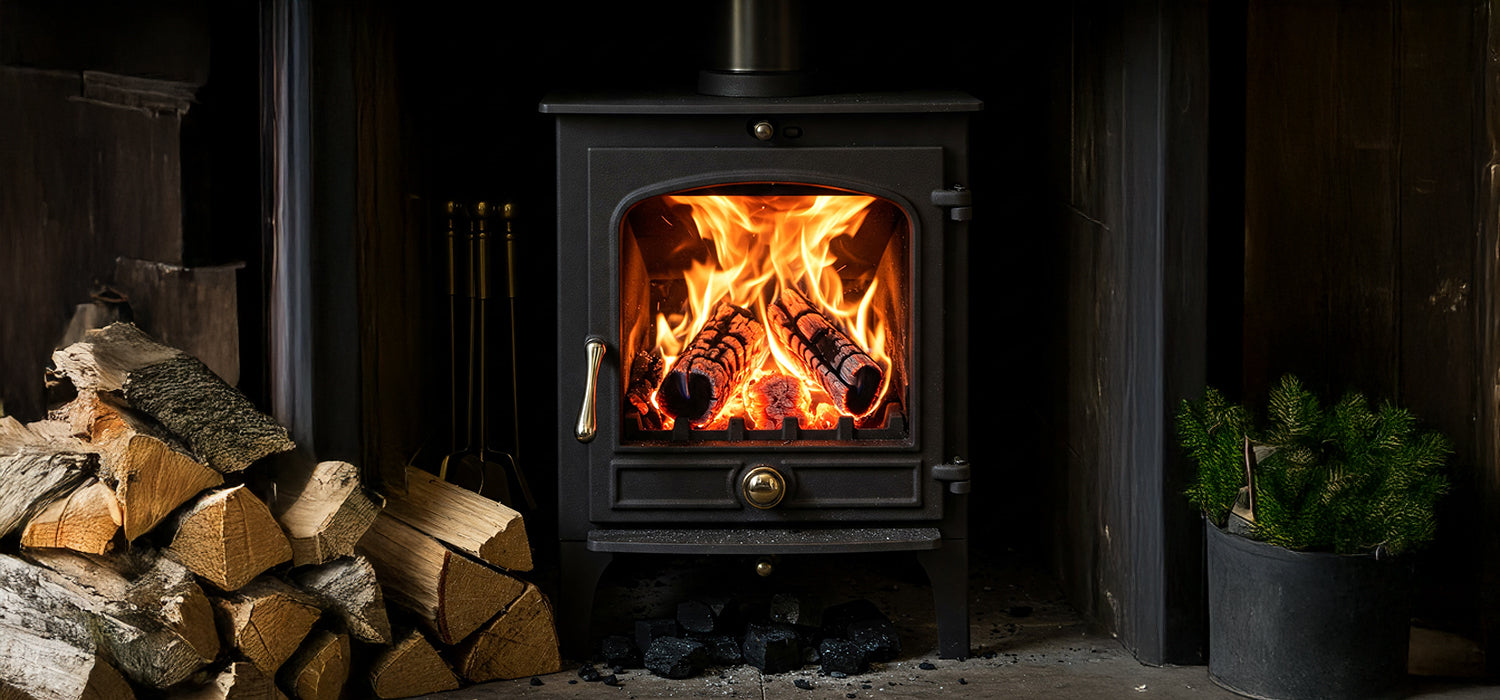
Log Burner Distance from Combustibles: Stay Safe and Warm
Thinking of cozying up by your log burner? Great idea—just don’t let your furniture join the fire party! The short answer: keep at least 150mm on the sides and 300mm in front of combustibles. Want to know which log burner to buy and how to set it up safely? Keep reading!
Understanding Minimum Clearance Requirements
Installing a log burner isn’t just about creating a cosy atmosphere; it’s about making sure your home is safe from fire hazards. One of the most important things to get right is the clearance between your stove and combustible materials. If you’re wondering how far to keep your stove from things like wooden beams or soft furnishings, you’re not alone. Let’s break down the minimum clearance requirements and why they matter.
Importance of Building Regulations and Manufacturer Guidelines
In the UK, building regulations (Approved Document J) and your stove's manufacturer instructions are your best friends when it comes to safe stove installation. These guidelines set out the minimum safe distances your stove must be from combustibles. Following these rules isn’t just about ticking boxes; it’s about protecting your home and your loved ones from potential fire hazards. Manufacturers provide these guidelines based on the design of their stoves, and regulations ensure you're compliant with safety standards. So, always follow both the manufacturer’s recommendations and local regulations—because doing so could save you from a costly mistake (or worse).
Defining "Combustible Materials"
Combustible materials are anything in your home that can catch fire when exposed to heat. This includes obvious things like wooden beams, carpets, furniture, and curtains, but also less obvious materials like plasterboard, MDF, and chipboard. Even if a material doesn’t catch fire easily, it can still warp, crack, or discolour if it’s too close to your stove. To be safe, treat everything as potentially combustible unless you know for certain it’s not. Remember: heat doesn’t have to be in direct contact to cause damage.
Specific Distance Requirements for Different Parts of the Burner
Now that we know why clearance is important, let’s take a closer look at the specific distances required for various parts of your stove. Different areas of the stove produce different amounts of heat, so the distance between them and combustibles varies.
Distance from the Body of the Stove
One of the most important parts of stove installation is ensuring that there’s enough space around the body of the stove. For safety, it’s recommended to leave at least 150mm (6 inches) of clearance on the sides and rear of the stove. This allows heat to dissipate safely and prevents any nearby materials from overheating. At the front, you’ll need at least 300mm (12 inches) of space—this is especially important if you have pets or children who might get too close.
But what happens if you’re tight on space? Well, modern stoves with better insulation may allow for closer installation, so always check the manufacturer’s guidelines before you assume what’s safe.
Distance from the Flue Pipe
The flue pipe, which expels smoke from your stove, also needs to be installed with care. It should be at least 50mm away from any combustible materials. This clearance ensures that the heat emitted from the pipe doesn’t cause nearby surfaces to overheat and catch fire. It’s easy to forget about the flue when setting up, but it’s just as important as the stove itself in ensuring safe operation.
Distance Above the Stove
The area above your stove is often overlooked, but it’s just as important when it comes to safety. You’ll need a minimum of 800mm clearance above the stove to allow the hot air to rise and ventilate properly. This distance helps to ensure there’s enough room for air circulation, which is key to both safe stove operation and efficiency. If you have a particularly high or enclosed ceiling, check the stove’s manual, as you may need more space.
How to Protect Combustible Surfaces
Sometimes, you can’t avoid having combustible surfaces near your stove. But don’t worry—there are ways to protect these surfaces and reduce the required clearance, ensuring your stove still fits into your space without compromising safety.
Using Heat Shields and Non-Combustible Materials
One of the most effective ways to protect your home is by using heat shields. These are fire-resistant panels that can be installed behind your stove to protect walls and surfaces from excessive heat. A well-placed heat shield can reduce the necessary clearance by up to 50%, making it a great option if you’re working with limited space. Non-combustible materials like stone or brick are also excellent choices to use around your stove. They act as a natural heat barrier, helping to protect nearby surfaces and reduce heat transfer.
Wall Boards and Spacers
Another method of protection is using wall boards and spacers behind your stove. Wall boards made from heat-resistant materials like cement or metal can be installed to protect your walls from the heat. Spacers are used to create a gap between the stove and the wall, ensuring airflow and preventing direct heat contact. This setup can reduce the required clearance and provide a safe distance between your stove and combustible surfaces.
Measuring and Ensuring Correct Clearances
Once you’ve installed your stove and ensured there’s enough clearance from combustible materials, it’s time to double-check your measurements. The last thing you want is to realise your stove is too close to a wall or piece of furniture after everything is set up. Take the time to carefully measure the distance between the stove and all nearby materials, ensuring everything is in line with the manufacturer’s guidelines and regulations.
If you’re unsure about the clearance or need help with installation, don’t hesitate to consult a HETAS-registered installer. These professionals are trained to ensure your stove is installed safely and up to code, giving you peace of mind. It’s always better to get it right the first time, rather than dealing with safety issues down the road.
By following the proper clearance guidelines and using the right protective materials, you can enjoy the warmth and comfort of your log burner with complete peace of mind. Whether you're fitting a new stove or adjusting an existing one, the key is to give your stove enough space to breathe—and keep everything around it safe from the heat.
Other content we think you'll love
- What Log Burner Do I Need? The Cosy Homeowner’s Guide
- What Log Burner to Buy: The Cosy Homeowner's Guide
- How to Remove a Wood Stove: A Step-by-Step Guide
- How to Fit a Log Burner (Without Setting Off the Smoke Alarm)
- What Size Log Burner Do I Need? A Simple Guide to Finding the Perfect Fit
- Where to Put a Log Burner: Finding the Perfect Spot for Warmth and Style
- Can You Take a Log Burner When You Move? Here's What You Need to Know
- How to Fit a Wood Burner in a Conservatory
- Log Burner for New Build: What You Need to Know Before You Install One
- Installing a Log Burner Near a Gas Pipe: What You Need to Know
- Log Burner Near Curtains: How Close Is Too Close – And How to Stay Safe
- Can You Use a Log Burner Without a Liner?
- Can You Have a Log Burner with Underfloor Heating?

